To most people, the world’s greatest innovators are simply a nuisance. From June beetles repeatedly crashing into lit windows to mosquitoes buzzing about our blood-engorged ears, flying insects are more often smacked than admired. But to the researchers who ask how insects take flight, these winged wonders are dazzling.
Insects were the Earth’s first fliers. Since they first lifted off roughly 400 million years ago, they’ve developed an impressive array of adaptations to help them navigate the skies. From internal gyroscopes that keep house flies flush with kitchen counters to wing movement patterns that allow them to hover like helicopters, insects have invented a diverse set of solutions to the problems that keep the rest of us grounded. It has taken an interdisciplinary army of scientists, collecting clues on macroscopic and microscopic levels, to tease out the mechanisms that keep flying insects aloft.
“It’s really a problem that can be studied from global to molecular scale,” says biologist and neuroscientist Michael Dickinson of the California Institute of Technology, who works on flight and other behaviors in the fruit fly Drosophila melanogaster. “I know people who study the molecules in the neurons of the muscles that generate flight, and I have colleagues who use radar to track insects moving across the English Channel. It’s not impossible to find other branches of science that have that scope, but many don’t.”
Just as insect flight has evolved and diversified, so too have the methods scientists use to study it. Among the first researchers to investigate insect flight were eighteenth-century naturalists, who relied heavily on observation and simple experiments, like removing body parts to find out how the structures influenced flight control.

Scientists have developed elaborate equipment to study insect flight — virtual-reality-like “arenas” that display light patterns to tethered flies and measure their flight responses, such as this one in Michael Dickinson’s lab at Caltech.
CREDIT: FLORIS VAN BREUGEL | WWW.ARTINNATUREPHOTOGRAPHY.COM
Today, the study of insect flight engages researchers with backgrounds in neuroscience, aerodynamics, entomology and other fields. They use a broad suite of techniques to find out how moths navigate nighttime skies or how dragonflies hover. Mathematical equations elucidate the physics of flight, while high-speed cameras allow researchers to scrutinize tethered bugs’ acrobatic aerial maneuvers. Genetic modification and microscopy help reveal the musculature behind flight mechanics, and virtual flight simulators trick restrained animals into behaving as if they’re airborne.
“It’s a marvel of evolution,” says Jane Wang, a theoretical physicist and insect flight researcher at Cornell University who specializes in dragonfly flight. Even the latest technology can’t pull back the veil on all its mysteries: High-speed cameras don’t, for example, track the ways that wings move with adequate precision.
Still, such techniques have allowed researchers to identify numerous adaptations that make insect flight possible. Many of these help with flight’s most important motivator: nutrition. “Flies fly to get mates and they fly to defend territories,” Dickinson says, “but most insects fly to find food. They’re flying noses.”

A four-second exposure reveals the zig-zaggy flight path of a fruit fly (Drosophila melanogaster) as it follows an odor plume emitted by a fermenting strawberry. The photograph was taken by Floris van Breugel, a former researcher in Michael Dickinson’s lab who’s now at the University of Washington, where he studies how insects integrate sensory information to efficiently search for food.
FLORIS VAN BREUGEL | WWW.ARTINNATUREPHOTOGRAPHY.COM
Homing in on dinner
When he talks about fruit flies’ odor-detecting abilities, Dickinson has to practice restraint.
“Scientists shouldn’t say the word unbelievable,” he says, recounting the number of Drosophila he’s seen track down fumes from fermenting fruit and yeast over kilometer distances when released into open fields. “It’s shocking,” he says, “but it’s not magic. It’s just that they have supersensitive noses and very clever ways of responding to the odor when they detect it.”
Though fruit fly olfactory organs are truly impressive, the real efficiency behind the ability to find spotty bananas or dregs in a wine glass lies within the animals’ highly effective, three-part search method.
Researchers first observed two of the three behaviors over a century ago. Fruit flies tend to turn toward odor plumes, then zigzag back and forth until they find the source of stink. It took a wind tunnel and a three-dimensional, motion-tracking camera system to uncover the third behavior. In 2014, Dickinson and biologist Floris van Breugel, then a graduate student in Dickinson’s lab, published a study detailing how the flies, after being released into a wind tunnel, responded when exposed to short bursts of ethanol, a compound found in rotting fruit. As the flies chased the scent, the researchers recorded over 50,000 flight trajectories.
Just as they did a century ago, the creatures turned toward the odor plumes and zigzagged back and forth at oblique angles, searching equally in both vertical and horizontal directions. The flies then buzzed around the edges of high-contrast shapes projected on the tunnel’s walls and floor.
But when no ethanol was present, the flies spent less time around the same shapes. That led the researchers to suspect that flies use odors as cues to start hunting for figures, which could lead them to fruit.
Similar experiments show the same behavior in mosquitoes, although the odor plume in their case is carbon dioxide (which their human prey exhales) and the blood-hungry insects also use thermal cues to find hosts. After first having their noses tickled by trace clouds of CO2, the mosquitoes hovered around high-contrast objects, and finally focused on warm spots within those objects when close enough to detect them.
Search methods like these help insects find food. But some insects have to fly great distances to find what they’re looking for. Foraging bees will fly several kilometers in search of food. Monarch butterflies fly thousands of kilometers to find their overwintering grounds.
One trait that enables such feats lies not within the insects’ wings, but deep in their brains.
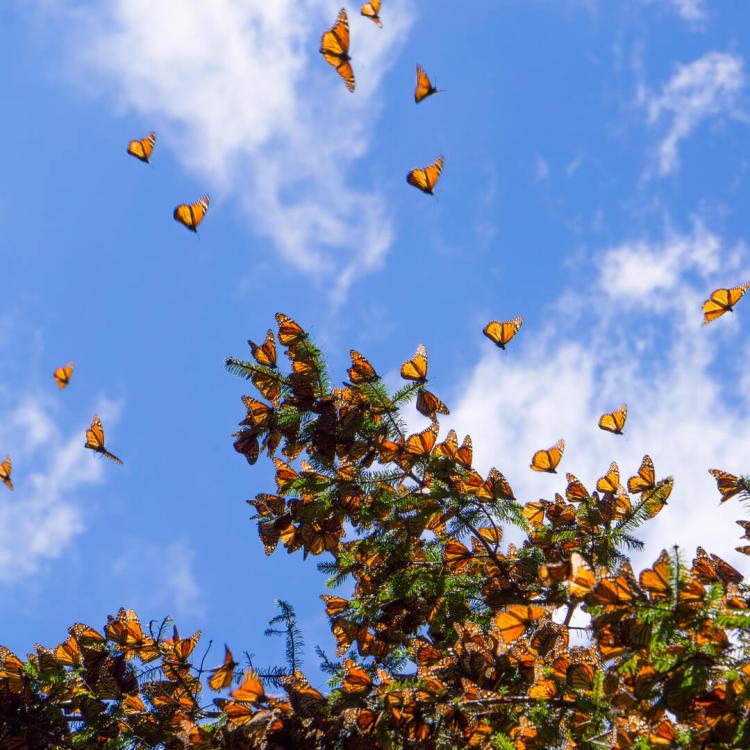
Monarch butterflies, shown here on a tree branch in Michoacan, Mexico, migrate dizzying distances each year.
CREDIT: JHVEPHOTO/SHUTTERSTOCK.COM
A better brain for navigation
All living, flying insects possess a core navigational system, which probably developed early in their evolution. “This is ancient, ancient circuitry,” Dickinson says. “It’s been tweaked and tweezled, but not a lot of super-new things have emerged from the flight system. It’s been a very successful kit.”
This circuitry is shared among many insects, from fruit flies and butterflies to locusts and dung beetles. It confers a set of navigational abilities, almost like a celestial compass hidden inside the brain.
Indeed, fruit flies observed inside transparent-ceilinged enclosures use celestial markers to maintain a constant heading. By detecting polarized light, they can keep flying forward, even if the enclosure is rotating. Other insects, like monarch butterflies, detect changes in day length and temperature to help them travel paths rivaling those of migratory birds.
Among the farthest-traveling of migratory insects are globe-skimmer dragonflies, which have touched their tiny feet upon every continent except Antarctica. They traverse entire oceans en masse. Their travel distances rank them among the world’s most cosmopolitan migrators, such as humpback whales and leatherback sea turtles.
$[$PB_DROPZONE,id:donate-promo$]$“They fly marvelously well compared to most modern insects,” says Cornell’s Wang, “and sometimes even better, because they’re predators.”
Dragonflies can predict the path of moving prey, fly more than seven miles a day, and even mate midair. Among their most impressive feats is mastery of one of the most energetically expensive forms of locomotion: hovering.
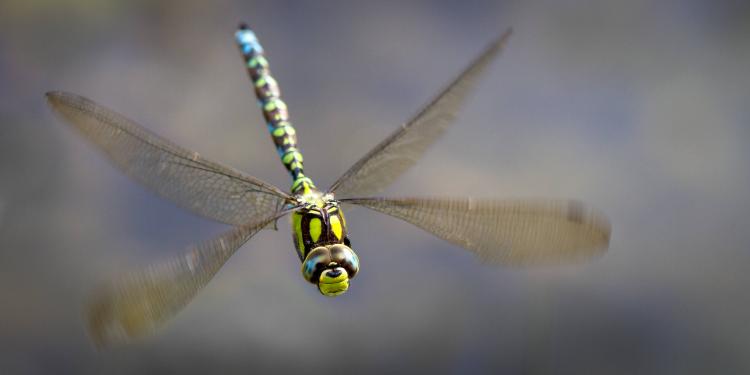
The independent and asymmetric movement of fore and hind wings grants this Southern hawker dragonfly (Aeshna cyanea) the rare ability to hover midair.
CREDIT: STUART LECHE/GETTY IMAGES
Hovering: not just for the birds
Hovering is hard. If an animal wants to do it, it has to generate enough lift to pull its body into the air, without any aid from wind. Few animals have the capability.
Birds generally rely on air currents to fly. Dragonflies don’t need the help. Most flying insects simply flap their wings back and forth in symmetrical motion to achieve flight, but dragonflies use asymmetrical wing strokes — a strategy, Wang says, that sets dragonflies apart as among the “best hoverers.”
Each stroke begins by pushing the wings forward, then down, moving the wings along an inclined plane (other flying insects flap back and forth along a horizontal plane). As the stroke ends, the wings slice up and then backward, following the same plane. The downstroke creates upward drag, which supports the insect’s weight.
The forces that enable hovering — or flight at all — can easily be seen in a swimming pool. Imagine you’re treading water, moving your arms horizontally forward and back to stay afloat. This is akin to how flies fly, flapping their wings back and forth across a horizontal plane. Dragonflies, however, modify their wing movement to hover. Imagine, instead of a straight back and forth motion, that your palms-down arms move forward and down, then backward and up as your palms rotate skyward. This distinction makes the difference between hovering and simply flapping to fly.
At the end of each stroke, swirling vortices form at the edges of your hands. It is such vortices, in air, that generate the lift that carries a dragonfly’s body upwards. “You’re effectively pushing the fluid down,” says Wang, “and the wing experiences an upward force.”
While hovering in place occupies one point on the spectrum of flying feats, the midair rotations and tight direction changes of flies are equally impressive. Scientists think that the ability to dodge swatters and roll past rolled-up magazines stems largely from a specific physical adaptation: halteres.
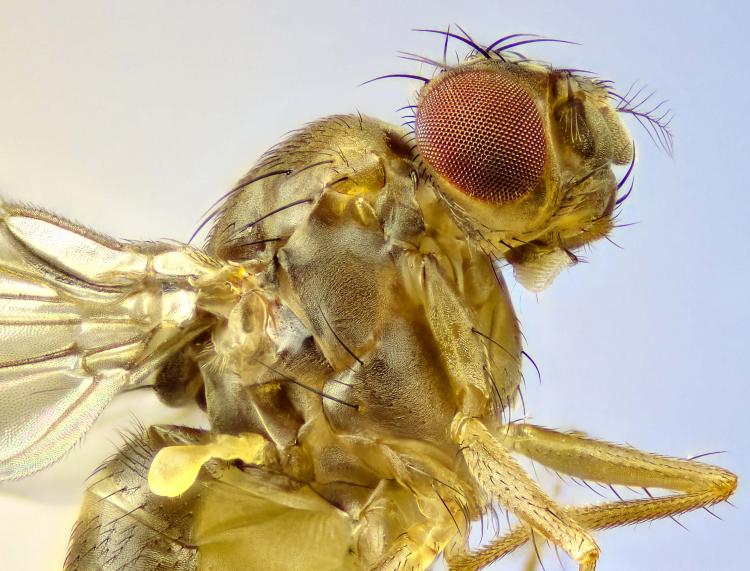
Flies such as Drosophila melanogaster have one pair of wings and one pair of modified hindwings, or halteres. Often described as the fly’s personal gyroscope, the club-like structures (lower left) provide crucial flight information.
CREDIT: MIKROMAN6/GETTY IMAGES
Halteres: more than gyroscopes
Few insect adaptations have attracted as much attention as halteres. Popularly known as the fly’s personal gyroscopes, these are club-shaped protrusions in spots where, millions of years ago, flies once had hind wings. They detect rotational changes in a fly’s position while the creature is airborne, and provide crucial information for correcting position or executing acrobatic aerial maneuvers.
“To me, this adaptation is amazing,” says Wang. “Somehow, they managed to find a different [evolutionary] route and fly just as well with two wings.”
This video of a tethered soldier fly shows halteres in action as the wings flap.
SOURCE: T. DEORA ET AL, PNAS 2015, VOL. 112 (5) PP. 1481-1486
Scientists first suspected that halteres somehow influence balance when, in 1714, naturalist William Derham learned that flies with surgically removed halteres struggled to keep aloft. John William Sutton Pringle, a twentieth-century British zoologist and seminal figure in insect flight research, later explored the function of the haltere in much greater detail, publishing an article on its gyroscopic properties in 1948 and a more expansive book on insect flight in 1957. Observations of haltere-less flies regaining balance when tethered to keep from rotating, along with other factors, led Pringle to suggest the haltere’s gyroscopic nature.
Yet the halteres’ gyroscopic properties tend to distract from their other, often overlooked roles.
“They’re not just gyroscopes,” Dickinson says. “They’re also super precise timers, like a precision clock, if you will.”
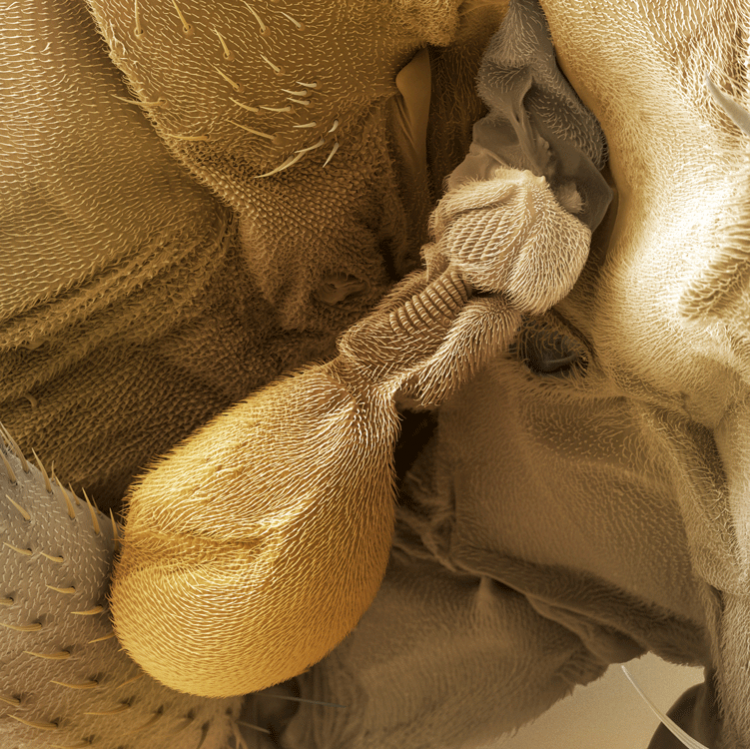
This colored scanning electron micrograph shows close-up detail of the haltere of a male fruit fly.
CREDIT: CHERYL POWER/SCIENCE SOURCE
Just as our own bodies search for the optimal time to launch each leg forward while running, specialized cells embedded at the base of halteres tell flies when to contract and when to relax their flight muscles. Halteres are complicated organs, Dickinson says, complete with hundreds upon hundreds of sensory cells that inform everything a fly does, from last-chance erratic maneuvers to steady flight.
But until recently, it has been difficult to figure out which cells are doing exactly what and when. New imaging techniques have allowed Dickinson and his colleagues to confirm what Pringle proposed over 70 years ago: Most of the halteres’ cells are active, even when the fly isn’t rotating, meaning they do much more than detect midair imbalance.
“This is something that’s not shared by all insects,” Dickinson says. “It enables flies to have a certain lifestyle — in particular, a rapidity of behavioral responses and the ability to fly extremely straight and turn extremely quickly — that other insects just don’t have.”
Another trait that empowers insects to live an aerial lifestyle lies just below the haltere, in the muscles that control wing-flapping.
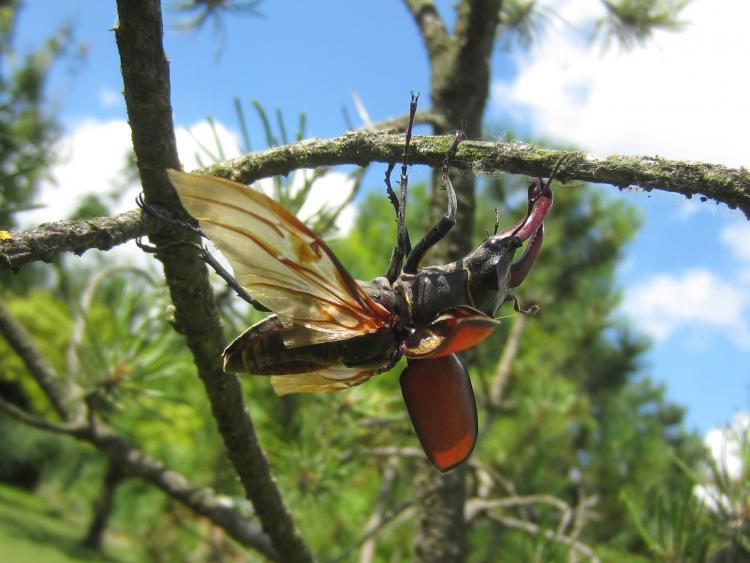
A stag beetle unfurls its wings. In beetles, the hind wings do the flying — the front ones have evolved into hard, protective cases that flip up when it’s time to take flight.
CREDIT: PIXABAY
Muscles made for more than lifting
The simple act of squatting down to pick up a fallen pencil employs a handful of muscles, each of which is controlled by multiple neurons (nerve cells). Flying insects also use muscles to power their aerial maneuvers. But they do far more with far less.
Controlling a fly’s more complex flight maneuvers takes, surprisingly, roughly a dozen muscles. These muscles are clustered at the base of the wing, and they assist several larger muscles that do the actual flapping. Like strings on a kite, these smaller muscles pull to distort the shape of the wing and alter the pilot’s course.
Each of these small muscles, called direct flight muscles for their direct attachment to the wing, is connected to a single neuron. For comparison, the muscles that empower a hummingbird to flap its wings are connected to 100 times more neurons. Where birds need hundreds, bugs need only one.
To tease apart which muscles powered steering, Dickinson team members Theodore Lindsay and Anne Sustar used fruit flies whose muscles were genetically modified to glow when in use. Lindsay and Sustar secured single flies to a fixed wire, focused a microscope on their tiny bodies and stuck them inside a virtual flight simulator, which resembles something like a spinning fun-house tunnel.
Once the insect is inside, a panorama of spinning LEDs envelops its view and simulates the sensation of flying. The display can prompt a fly to bank left or right, or attempt to correct itself while in perceived flight. Active muscles will light up, revealing which ones are needed to execute which maneuvers.

In this experimental setup to study flight behavior, a genetically modified fruit fly, seen from below, is tethered inside an LED-illuminated drum (or arena) that displays moving patterns. As the fly beats its wings, a camera records the wing amplitudes to assess which way it’s trying to turn to try to stabilize the visual pattern. The fly has been engineered so that its active muscles will fluoresce when excited by blue light that is directed onto its body, enabling scientists to see which ones are used for various maneuvers.
CREDIT: FLORIS VAN BREUGEL | WWW.ARTINNATUREPHOTOGRAPHY.COM
Dickinson says the ubiquity of these muscular systems bears testament to their success — all flies have them, despite having diverged into distinct and diverse evolutionary groups millions of years ago. This stands in contrast to other traits that have changed more, like the shape of antennae or odor-detection methods.
Looming questions
Many puzzles surrounding insect flight remain, but collaboration across fields is helping to solve them. One promising strategy, Dickinson says, involves joint efforts among those who study sensory and motor systems.
“The two are merging,” he says. “Lots of us are really interested in how sensory info controls motor systems and how motor systems constrain the sensory system. Putting the two sides of the problem together is a major goal right now.”
Wang adds that flying insects “coordinate so many different precepts of physics, physiology, neuroscience, whatever you can think of. If you really want to understand the behavior of the whole organism, everything must play together.”
Despite ever-improving technology, insects are still small, making them difficult to track in large numbers. And the cells that form their bodies are even smaller, so it’s challenging for scientists to sort out their roles in flight. But those difficulties are dissolving, Dickinson says, as new gene-editing techniques like CRISPR/Cas9 promise even more lines of inquiry.
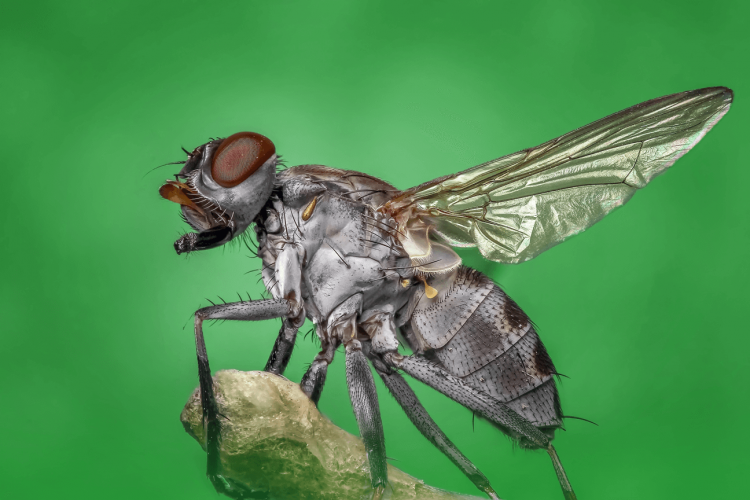
Lords of the skies: If this housefly looks a bit smug, who can blame it?
CREDIT: PIXABAY
“Just as the high-speed video was really a game changer in studying the biomechanics of flight,” he says, “I think these genetic tools are really a game changer in the physiology and neurobiology of flight.”




